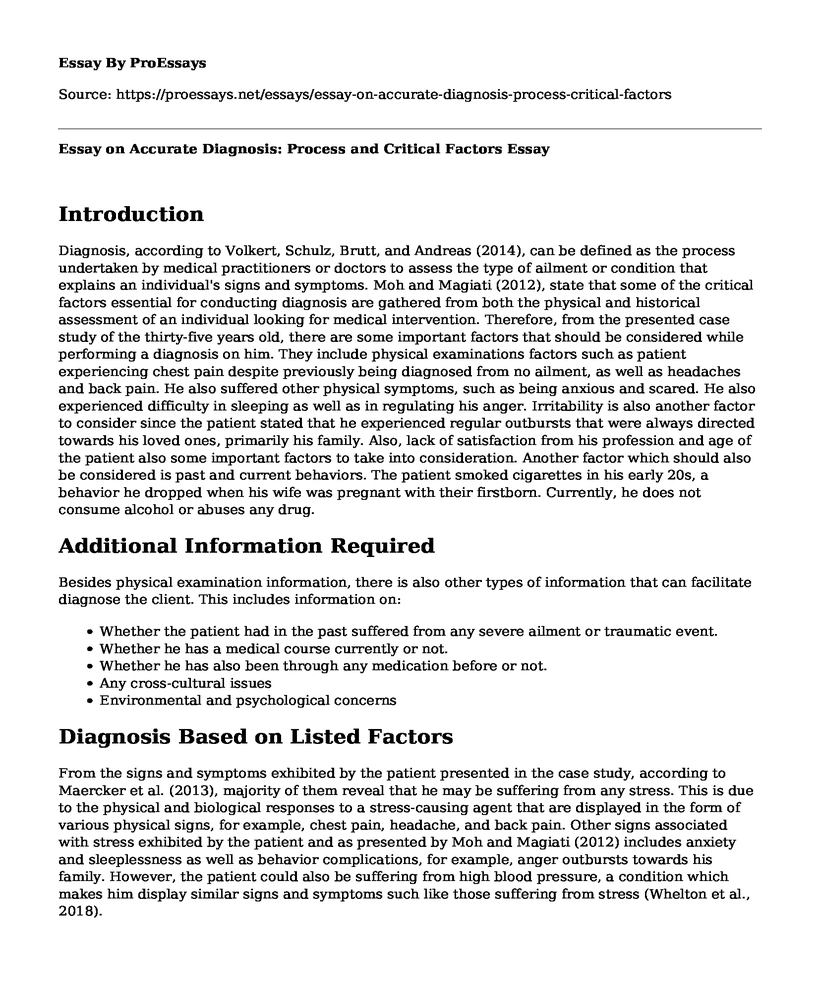Introduction
Diagnosis, according to Volkert, Schulz, Brutt, and Andreas (2014), can be defined as the process undertaken by medical practitioners or doctors to assess the type of ailment or condition that explains an individual's signs and symptoms. Moh and Magiati (2012), state that some of the critical factors essential for conducting diagnosis are gathered from both the physical and historical assessment of an individual looking for medical intervention. Therefore, from the presented case study of the thirty-five years old, there are some important factors that should be considered while performing a diagnosis on him. They include physical examinations factors such as patient experiencing chest pain despite previously being diagnosed from no ailment, as well as headaches and back pain. He also suffered other physical symptoms, such as being anxious and scared. He also experienced difficulty in sleeping as well as in regulating his anger. Irritability is also another factor to consider since the patient stated that he experienced regular outbursts that were always directed towards his loved ones, primarily his family. Also, lack of satisfaction from his profession and age of the patient also some important factors to take into consideration. Another factor which should also be considered is past and current behaviors. The patient smoked cigarettes in his early 20s, a behavior he dropped when his wife was pregnant with their firstborn. Currently, he does not consume alcohol or abuses any drug.
Additional Information Required
Besides physical examination information, there is also other types of information that can facilitate diagnose the client. This includes information on:
- Whether the patient had in the past suffered from any severe ailment or traumatic event.
- Whether he has a medical course currently or not.
- Whether he has also been through any medication before or not.
- Any cross-cultural issues
- Environmental and psychological concerns
Diagnosis Based on Listed Factors
From the signs and symptoms exhibited by the patient presented in the case study, according to Maercker et al. (2013), majority of them reveal that he may be suffering from any stress. This is due to the physical and biological responses to a stress-causing agent that are displayed in the form of various physical signs, for example, chest pain, headache, and back pain. Other signs associated with stress exhibited by the patient and as presented by Moh and Magiati (2012) includes anxiety and sleeplessness as well as behavior complications, for example, anger outbursts towards his family. However, the patient could also be suffering from high blood pressure, a condition which makes him display similar signs and symptoms such like those suffering from stress (Whelton et al., 2018).
Recommendations
I would recommend three things to the patients centered on the factors considered. First, I would suggest that he goes through various clinical diagnostic tests to determine the specific ailment he is suffering from, since physical diagnosis is not enough. Second, I would recommend that the patient takes deep sleep and regular bed rests, which would, for instance, help ease anxiety. Third, I would also suggest he undergoes intensive stress management initiative to help him reduce the level of stress.
Tools Used in the Assessment and Diagnosis
Some of the crucial tools that have been used include the Duke health profile, patient stress questionnaires, and DSM-5 as a guide to diagnose the type of mental disorder the patient is experiencing. Other tools that may be used during the clinical diagnosis include sphygmomanometer to measure blood pressure.
References
Maercker, A., Brewin, C. R., Bryant, R. A., Cloitre, M., van Ommeren, M., Jones, L. M., ... & Somasundaram, D. J. (2013). Diagnosis and classification of disorders specifically associated with stress: proposals for ICD11. World Psychiatry, 12(3), 198-206.
Moh, T. A., & Magiati, I. (2012). Factors associated with parental stress and satisfaction during the process of diagnosis of children with autism spectrum disorders. Research in Autism Spectrum Disorders, 6(1), 293-303.
Volkert, J., Schulz, H., Brutt, A. L., & Andreas, S. (2014). Meaning in life: Relationship to clinical diagnosis and psychotherapy outcome. Journal of Clinical Psychology, 70(6), 528-535.
Whelton, P. K., Carey, R. M., Aronow, W. S., Casey, D. E., Collins, K. J., Himmelfarb, C. D., ... & MacLaughlin, E. J. (2018). 2017 ACC/AHA/AAPA/ABC/ACPM/AGS/APhA/ASH/ASPC/NMA/PCNA guideline for the prevention, detection, evaluation, and management of high blood pressure in adults: a report of the American College of Cardiology/American Heart Association Task Force on Clinical Practice Guidelines. Journal of the American College of Cardiology, 71(19), e127-e248.
Cite this page
Essay on Accurate Diagnosis: Process and Critical Factors. (2023, Feb 11). Retrieved from https://proessays.net/essays/essay-on-accurate-diagnosis-process-critical-factors
If you are the original author of this essay and no longer wish to have it published on the ProEssays website, please click below to request its removal:
- Pharmacological Management of Anxiety and Depression
- Social Contributing Factors of Health Essay Example
- Essay Sample on Health Social Contributing Factors
- Healthy Breakfast: 9 Superfoods & Their Nutrients - Essay Sample
- Essay Sample on Ulcer Caused by Helicobacter Pylori: Destruction of Stomach Mucus Boundary
- Essay Example on Military Immunizations: Ethical Implications?
- Nurses Working Long Hours: A Help or a Hindrance? - Essay Sample







